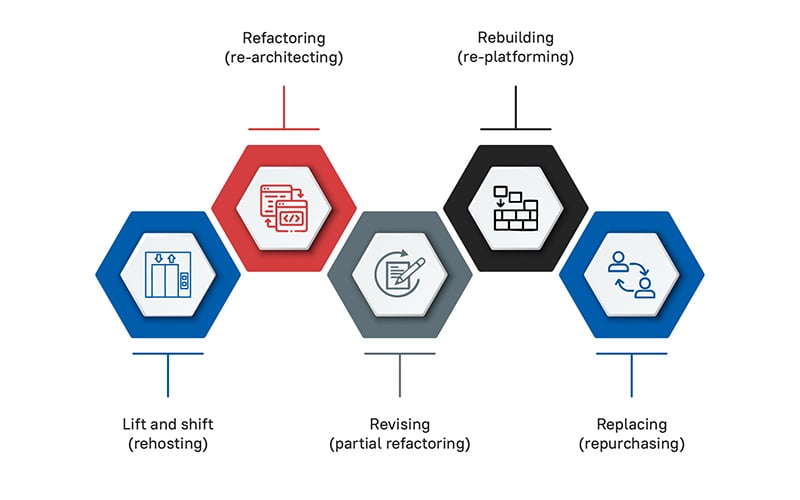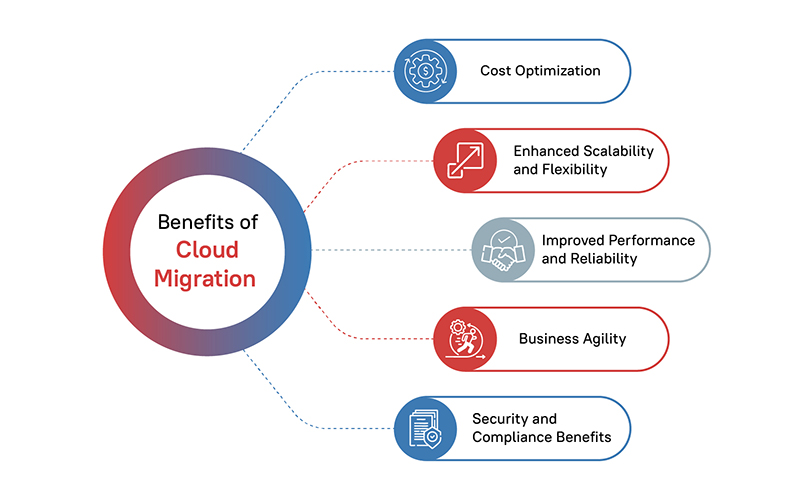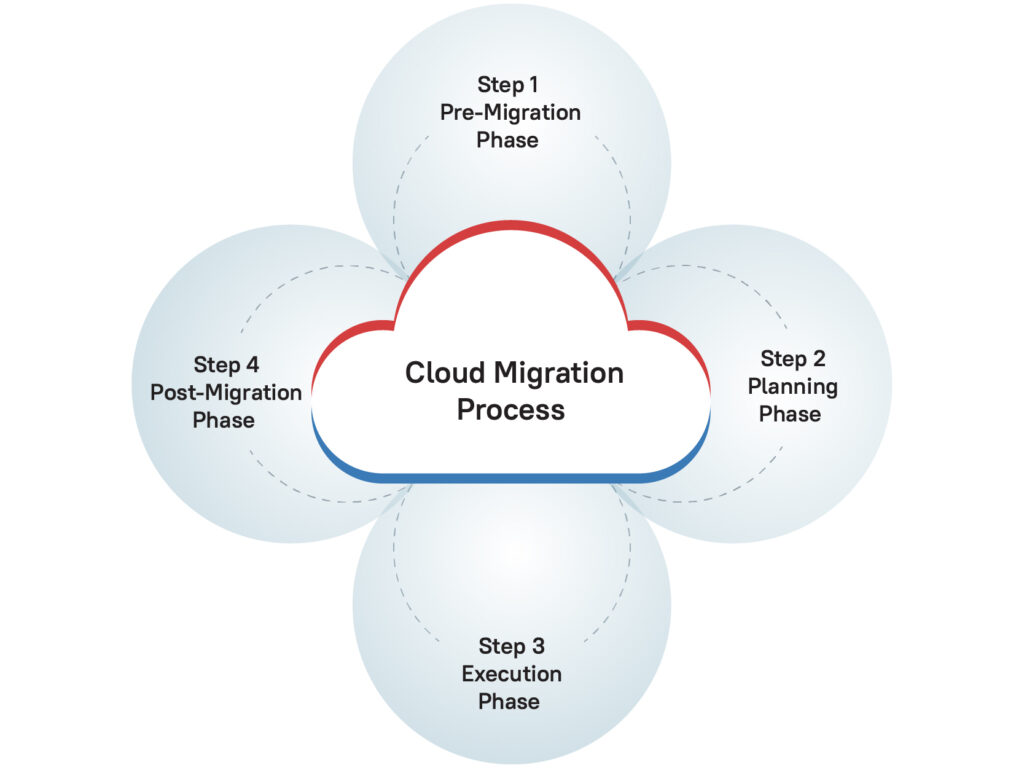Most companies approach cloud migration completely wrong.
They think it’s just about moving their servers to the cloud and calling it a day.
Because of this, they end up with higher costs, bad performance, and frustrated employees.
But when done right, cloud migration can be transformative.
So, what’s the difference between companies that succeed with cloud migration and those that fail?
It all comes down to having a solid cloud migration strategy.
Without a strategy, you’re flying blind. You’ll make costly mistakes, create security gaps, and end up with a mess that takes years to fix.
With the right strategy, you’ll transform your business into a lean, agile machine that can adapt to any market conditions.
In this comprehensive guide, you’ll discover everything you need to know about cloud migration strategy.
What is Cloud Migration Strategy?
Simply put, a cloud migration strategy is your roadmap for moving your digital assets from on-premises infrastructure to cloud-based platforms.
But it’s much more than just a technical plan – it’s a comprehensive approach that aligns your technology decisions with your business goals and priorities.
The beauty of having a well-defined cloud migration strategy is that it turns what could be an overwhelming and risky process into a series of manageable, planned steps. It helps you avoid common pitfalls like cost overruns, security gaps, or performance issues that can derail migration projects.
Remember, your cloud migration strategy isn’t set in stone. As you learn more about cloud technologies and gain experience with your initial migrations, you’ll likely refine and adjust your approach.
The key is starting with a solid foundation that gives you direction and helps you make consistent, informed decisions throughout your cloud journey.
Different Cloud Migration Strategies
When it comes to moving your applications and data to the cloud, you have several different approaches to choose from.
Each strategy has its own advantages, challenges, and ideal use cases.
Understanding these options will help you make the right choice for each of your applications and workloads.

Lift and shift (rehosting)
Lift and shift is exactly what it sounds like – you’re literally lifting your existing applications from your on-premises servers and shifting them to cloud infrastructure with minimal or no changes.
This approach is often the fastest and least disruptive way to get started with cloud migration. You’re essentially recreating your current server environment in the cloud, which means your applications continue to work exactly as they did before.
Your users won’t notice any difference in functionality, and your IT team doesn’t need to learn new application architectures right away.
The biggest advantage of lift and shift is speed. You can migrate applications quickly, often in a matter of days or weeks rather than months. This makes it an excellent choice when you’re under time pressure, perhaps due to expiring data center contracts or end-of-life hardware that needs immediate replacement.
However, lift and shift doesn’t take full advantage of cloud capabilities. You’re essentially paying cloud prices for on-premises performance.
Many organizations use lift and shift as their first step, then optimize applications later once they’re comfortable with cloud operations.
Refactoring (re-architecting)
Refactoring takes the opposite approach from lift and shift. Instead of moving applications as-is, you’re redesigning them to take full advantage of cloud-native features and services.
This might involve breaking down monolithic applications into microservices, implementing serverless functions, or redesigning data storage to use cloud databases.
The benefits of refactoring can be substantial. Your applications become more scalable, resilient, and cost-effective. They can automatically adjust to changing demand, recover quickly from failures, and take advantage of advanced cloud services like artificial intelligence, machine learning, and analytics platforms.
However, refactoring requires significant time, effort, and expertise. You’re essentially rebuilding applications from the ground up, which means extensive planning, development, and testing.
This approach works best for applications that are core to your business and where the investment in redesign will pay off through improved performance and capabilities.
Revising (partial refactoring)
Revising sits somewhere between lift and shift and full refactoring.
You’re making some modifications to your applications to work better in the cloud, but you’re not completely redesigning them.
This approach might involve updating your application configuration to use cloud databases instead of on-premise ones, modifying authentication to work with cloud identity services, or adjusting how your application handles file storage.
You’re making targeted improvements that provide cloud benefits without the complexity of a complete redesign.
Revising is often a practical middle ground when you want some cloud advantages but don’t have the time or resources for full refactoring. It allows you to improve application performance and take advantage of some cloud services while keeping migration complexity manageable.
Rebuilding (re-platforming)
Rebuilding involves creating entirely new versions of your applications using cloud-native technologies and platforms.
Instead of modifying existing code, you’re starting fresh with modern development frameworks, cloud services, and best practices.
Rebuilding makes sense when your existing applications are outdated, difficult to maintain, or can’t meet your current business needs. It’s also a good choice when you want to standardize modern development practices and take full advantage of cloud capabilities from day one.
The challenge with rebuilding is that it’s essentially a new development project. You need to gather requirements, design new systems, develop and test code, and train users on new interfaces.
However, the result is often a much better application that’s designed specifically for cloud environments.
Replacing (repurchasing)
Sometimes the best migration strategy is to replace your existing applications entirely with cloud-based software-as-a-service (SaaS) solutions.
Instead of moving your email server to the cloud, for example, you might switch to Office 365 or Google Workspace.
This approach works particularly well for common business applications like email, customer relationship management, human resources, or accounting software. Cloud-based alternatives often provide better features, security, and reliability than maintaining your own systems.
The main thing to consider here is replacing data migration and change management. You’ll need to move your existing data to the new system and train your users on new interfaces and workflows.
However, the long-term benefits of professional support, automatic updates, and improved functionality often outweigh these initial challenges.
Benefits of Cloud Migration
Now that you understand the different ways to migrate to the cloud, let’s explore why so many organizations are making this move.
Let’s dive into each of these key benefits to help you understand what cloud migration can do for your business:

Cost Optimization
One of the most compelling reasons to migrate to the cloud is the potential for significant cost savings.
But here’s what’s interesting – these savings come from multiple sources, not just cheaper hardware.
First, you eliminate the need for expensive upfront capital investments in servers, storage systems, networking equipment, and data center infrastructure. Instead of spending hundreds of thousands of dollars on hardware that depreciates over time, you pay for cloud resources as you use them.
Your operational costs typically decrease as well. You no longer need to pay for electricity to power and cool servers, facility costs for data center space, or maintenance contracts for hardware.
Cloud providers achieve economies of scale that individual organizations simply can’t match, and they pass some of those savings on to their customers.
Enhanced Scalability and Flexibility
Traditional IT infrastructure forces you to finalize long-term requirements months or even years in advance. If you guess wrong, you either waste money on unused resources or struggle with performance problems when demand exceeds capacity.
Cloud migration eliminates this guessing game entirely.
With cloud infrastructure, you can scale your resources up or down in minutes, not months. If your e-commerce site experiences a sudden surge in traffic during a flash sale, your cloud infrastructure can automatically add more computing power to handle the load.
When traffic returns to normal levels, those extra resources disappear, and so does the cost.
This flexibility extends beyond just computing power. You can quickly deploy new applications, test new ideas, and experiment with emerging technologies without significant upfront investments.
Improved Performance and Reliability
Cloud providers operate massive, globally distributed infrastructure that most organizations could never afford to build themselves.
When you migrate to the cloud, you gain access to this enterprise-grade infrastructure, often resulting in better performance and reliability than you could achieve on your own.
Your applications benefit from redundant systems, automatic failover capabilities, and global content delivery networks that ensure fast performance for users regardless of their location.
If one server fails, your applications automatically switch to backup systems without any interruption in service.
Business Agility
Perhaps the most transformative benefit of cloud migration is the business agility it provides.
Nowadays, the ability to quickly respond to new opportunities or market changes can make the difference between success and failure.
Cloud migration accelerates your time-to-market for new products and services. Development teams can provision testing environments in minutes, deploy applications globally with a few commands, and iterate rapidly based on customer feedback.
You gain the ability to quickly enter new markets or respond to competitive threats.
If a competitor launches a new service, you can rapidly deploy your own competing solution using cloud resources. If new regulations require data to be stored in specific geographic regions, you can comply quickly by deploying applications in appropriate cloud regions.
Security and Compliance Benefits
Contrary to common misconceptions, cloud migration often improves your security posture rather than weakening it.
Cloud providers invest billions of dollars in security measures, threat detection systems, and compliance certifications that most organizations could not afford to implement independently.
You benefit from professional security teams that monitor threats 24/7, advanced threat detection systems that use machine learning to identify suspicious activity, and automatic security updates that protect against newly discovered vulnerabilities.
Your data is typically encrypted both in transit and at rest, with sophisticated key management systems that ensure only authorized users can access sensitive information.
The combination of these benefits creates a compelling case for cloud migration.
Cloud Migration Process
Understanding the benefits of cloud migration is just the beginning.
To actually achieve these benefits, you need to follow a structured process that ensures your migration is successful, secure, and aligned with your business objectives.
Let’s walk through each phase of the migration process so you understand what’s involved and can plan accordingly.

Step 1 – Pre-Migration Phase
The pre-migration phase is all about understanding your current situation and defining your goals.
This might not be the most exciting part of the process, but it’s arguably the most important. The decisions you make during this phase will guide everything that follows.
To get started, you need to conduct a comprehensive inventory of your current IT environment. You need to know exactly what you have before you can decide what to move and how to move it.
Furthermore, you must document all your applications, databases, servers, network configurations, and dependencies between systems.
Last but not least, you need to establish your success criteria. You need to define specific, measurable metrics like cost savings targets, performance improvements, or availability goals. These criteria will help you make decisions throughout the migration process and evaluate results afterward.
Step 2 – Planning Phase
Once you understand your current environment and goals, it’s time to develop your detailed migration plan.
This phase is where you make the strategic decisions that will determine your migration’s success.
You need to decide if you’ll use a single public cloud provider, multiple providers, or a hybrid approach that keeps some systems on-premises. While doing so, you must consider factors like cost, available services, geographic coverage, and compliance requirements.
For each application in your inventory, you need to choose the most appropriate migration strategy.
Simple, stable applications might work well with a lift-and-shift approach, while core business applications might benefit from refactoring or complete rebuilding to take advantage of cloud-native features.
Most importantly, your data migration strategy needs special planning, particularly for large datasets that might require physical data transfer services or careful scheduling during off-peak hours to minimize business disruption.
Step 3 – Execution Phase
The execution phase is where you actually perform the migration work according to your carefully developed plans.
You should start by setting up your cloud infrastructure according to your architectural designs. This involves configuring networks, security groups, identity management systems, and monitoring tools before you begin moving any applications to the new environment.
Your first migration should be a pilot project using a simple, non-critical application. This pilot allows you to validate your processes, identify any unexpected issues, and refine your procedures before moving to more important systems.
You must follow your detailed runbooks carefully and execute comprehensive testing for each migrated component.
This testing should cover all functionality, performance under various load conditions, integration with other systems, and disaster recovery procedures to ensure everything works properly.
Step 4 – Post-Migration Phase
The post-migration phase continues your work after applications are successfully running in the cloud environment.
You need to conduct thorough validation of all migrated systems to ensure they’re performing as expected. This validation should verify that performance meets or exceeds your baseline measurements, and that all functionality works correctly in the new environment.
Moreover, planning for ongoing optimization and improvement is essential because cloud migration represents the beginning of a continuous modernization journey rather than a one-time project.
You should establish processes for regularly reviewing and improving your cloud environment while taking advantage of new services and capabilities as they become available.
Cloud Migration Best Practices
Knowing the migration process is essential, but following proven best practices can make the difference between a successful transformation and a costly disaster.
That said, you don’t need to implement every best practice from day one, but understanding these principles will help you make better decisions throughout your cloud journey.
Strategic Planning and Governance
Strategic planning and governance form the foundation of successful cloud migrations. Without proper planning and oversight, even technically sound migrations can fail to deliver business value or create new operational challenges.
You should establish a cloud center of excellence or governance team early in your migration journey. This team needs to include representatives from IT, security, finance, and key business units who can make decisions about cloud adoption policies, standards, and procedures.
The team should have clear authority to enforce standards and resolve conflicts that arise during migration.
You also need to establish clear roles and responsibilities for cloud operations. Who has permission to provide resources? Who’s responsible for monitoring and optimization? How are security incidents handled? These questions should be answered before you begin significant cloud deployments.
Phased Implementation
Attempting to migrate everything to the cloud simultaneously is one of the most common causes of migration failure.
A phased approach reduces risk, allows for learning and adjustment, and provides opportunities to demonstrate value along the way.
You should start with pilot projects that have limited scope and business impact. These pilots allow you to test your migration processes, validate your assumptions about cloud performance and costs, and build confidence within your team.
Each phase should have clear success criteria and checkpoints where you evaluate progress before moving to the next phase. This allows you to pause and address any issues that arise rather than compounding problems across multiple applications.
You should also plan buffer time between phases to accommodate unexpected challenges or optimization of work.
Comprehensive Security and Compliance
Security considerations often become more complex in cloud environments, but they also offer opportunities for improved security posture if handled properly.
You need to adapt your security practices for cloud computing rather than assuming that existing controls will work the same way.
You should implement a shared responsibility model that clearly defines what security controls the cloud provider manages and what remains your responsibility. This varies significantly between different types of cloud services, so you need to understand the security implications of each service you plan to use.
Network security in cloud environments differs from traditional approaches. You should implement network segmentation using cloud-native tools like security groups and network access control lists.
Virtual private networks and private connectivity options help protect data in transit between cloud and on-premises systems.
Data and Dependency Management
Data migration often represents the most complex and risky aspect of cloud migration projects.
Poor data management can lead to extended downtime, data loss, or performance problems that persist long after migration completion.
You should start by conducting a thorough data audit that identifies all the data you need to migrate, where it’s currently stored, how it’s used, and what dependencies exist between different data sets.
This audit often reveals data that’s no longer needed and can be archived or deleted before migration, reducing the scope and complexity of your project.
Data classification, on the other hand, helps you prioritize migration activities and choose appropriate security controls. You should categorize your data based on sensitivity, business criticality, and regulatory requirements.
Highly sensitive data might require special handling during migration and additional security controls in the cloud.
Continuous Optimization and Change Management
Cloud migration is not a one-time project but the beginning of an ongoing optimization journey.
The dynamic nature of cloud computing provides continuous opportunities for improvement, but it also requires ongoing attention to maintain optimal performance and costs.
You should establish regular review processes that evaluate your cloud environment’s performance, costs, and alignment with business objectives. These reviews might be monthly for cost optimization, quarterly for performance assessment, and annually for strategic alignment.
Regular reviews help you identify optimization opportunities and ensure that your cloud environment continues to meet your needs.
Planning your cloud migration? Our detailed Cloud Migration Strategy Whitepaper includes step-by-step process, potential risks, and mitigation strategies. [Get Your Free Copy]
Conclusion
Cloud migration represents one of the most significant technological transformations your organization can undertake and getting it right can fundamentally change how you operate, compete, and grow.
This is where partnering with experienced cloud migration experts can provide significant value and peace of mind.
Analytix Solutions specializes in helping organizations like yours successfully navigate the cloud migration process from initial strategy through ongoing optimization.
Our experienced team of cloud migration experts can help you develop a comprehensive migration strategy, choose the right approaches for your specific applications, and execute your migration with minimal business disruption.
Contact Analytix Solutions today for a consultation and discover how we can help make your cloud migration a strategic success rather than a technical challenge.
